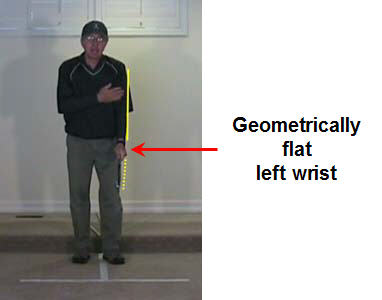Post by imperfectgolfer on Jul 15, 2012 9:33:48 GMT -5
See this 3jack forum thread.
richie3jack.proboards.com/index.cgi?board=general&action=display&thread=3657&page=1
The question is whether one needs to rotate the left arm/forearm counterclockwise in the downswing.
Tapio responded by producing this video to explain that one doesn't need to rotate (supinate) the left forearm between P5.5 and P7.
I think that he is wrong in his video-explanation.
Note that Tapio uses a neutral left hand grip, which means that the back of his FLW must face the target at impact.
Here is Tapio demonstrating his shallow clubshaft angle at P5.5.

He states that he simply rotates his body/arms/club as a single unit ("whole system") from that position into impact without rotating (supinating) his left forearm. I think that he is wrong and that he is not doing what he claims that he is doing.
Look at the back of his FLW in that image - it is parallel to a shallow inclined plane. How did he get it to rotate flat onto the inclined plane during his backswing action if he didn't rotate his upper torso 90+ degrees from his address position? He must have rotated his left arm/forearm more than he rotated his upper torso (left shoulder socket). He therefore has to reverse the process in the downswing to get the back of his FLW to face the target at impact.
I think that the only golfers who don't have to rotate their left forearm in the backswing (pronation) and therefore downswing (supination) are golfers who use an ultra-strong left hand grip (eg. Dominic Mazza).
Try a simple experiment - adopt a neutral left hand grip (GFLW) with your left arm straight-in-line with your left shoulder socket - as I demonstrate in this next photo.

Now try and get to the P2.5/P5.5 position with the back of your GFLW parallel to a shallow inclined plane (as Tapio demonstrates in that capture image) - but do not allow your upper torso to rotate >45-60 degrees during that process. I believe that it is biomechanically impossible to achieve that goal of laying the GFLW flat onto the surface of the inclined plane (parallel to the surface of the inclined plane) if you do not pronate your left forearm.
Jeff.
richie3jack.proboards.com/index.cgi?board=general&action=display&thread=3657&page=1
The question is whether one needs to rotate the left arm/forearm counterclockwise in the downswing.
Tapio responded by producing this video to explain that one doesn't need to rotate (supinate) the left forearm between P5.5 and P7.
I think that he is wrong in his video-explanation.
Note that Tapio uses a neutral left hand grip, which means that the back of his FLW must face the target at impact.
Here is Tapio demonstrating his shallow clubshaft angle at P5.5.

He states that he simply rotates his body/arms/club as a single unit ("whole system") from that position into impact without rotating (supinating) his left forearm. I think that he is wrong and that he is not doing what he claims that he is doing.
Look at the back of his FLW in that image - it is parallel to a shallow inclined plane. How did he get it to rotate flat onto the inclined plane during his backswing action if he didn't rotate his upper torso 90+ degrees from his address position? He must have rotated his left arm/forearm more than he rotated his upper torso (left shoulder socket). He therefore has to reverse the process in the downswing to get the back of his FLW to face the target at impact.
I think that the only golfers who don't have to rotate their left forearm in the backswing (pronation) and therefore downswing (supination) are golfers who use an ultra-strong left hand grip (eg. Dominic Mazza).
Try a simple experiment - adopt a neutral left hand grip (GFLW) with your left arm straight-in-line with your left shoulder socket - as I demonstrate in this next photo.

Now try and get to the P2.5/P5.5 position with the back of your GFLW parallel to a shallow inclined plane (as Tapio demonstrates in that capture image) - but do not allow your upper torso to rotate >45-60 degrees during that process. I believe that it is biomechanically impossible to achieve that goal of laying the GFLW flat onto the surface of the inclined plane (parallel to the surface of the inclined plane) if you do not pronate your left forearm.
Jeff.

